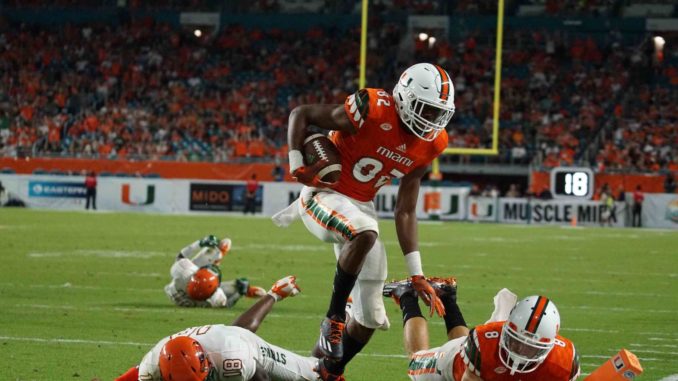
Preview articles often feature statistics found at footballstudyhall.com. Check that site out for more information.
Miami (4-2) at Virginia Tech (4-2)
(Thursday, 7 PM, ESPN)
F/+ Projected Spread: Miami -4
When Miami has the ball: The Hurricanes’ offense, and QB Brad Kaaya in particular, has been frustratingly inconsistent this year, but it still has been an above-average unit. It’s more explosive than efficient, and that goes for both the running and passing attacks. Miami is the kind of offense that can torch you for a long TD several times in a game but also go 3-and-out or gain 6 yards on a 3rd-and-8. Kaaya looks lost at times and still manages to average 8 yards per play – another mark of explosion over efficiency. Virginia Tech is excellent at stopping both explosion and efficiency, but if you’re going to attack them with one or the other, you’re more likely to break a long play than string together an 11 play, 78 yard drive. The Hokie defense has been quite good, and it really doesn’t have much of a weakness. The closest thing to it may be explosive pass plays allowed, so Miami’s best advantage may be with Kaaya taking some well-timed shots downfield, possibly to freshman Ahmmon Richards (21.1 ypc / 13.3 ypt). The Hokies, however, are only a tad susceptible to those plays because they’re so turnover-hungry in the secondary. The back 7 has disrupted 27 passes already this year, picking off 8. There’s not a clear road map to success against the Hokie defense, but Miami is capable of big plays, so that’s what it may come down to.
Players to watch: QB Brad Kaaya (1373 yds, 10:4, 62%, 8.0 ypp) / DB Greg Stroman (3 INT / 6 PBU)
When Virginia Tech has the ball: The nice things I said about the Virginia Tech defense also apply to Manny Diaz’s attack in Miami. They’re not precisely the same – Miami does better limiting big plays than it does in the efficiency game – but suffice to say, the Hurricanes defense has been very good so far. They rank in the top 5 nationally in points allowed inside the 40 (3.00 points per trip), which means that even when you string together a few plays, your drive could easily wind up spinning its wheels. This, and the strength of their D in general, starts up front with the nation’s most disruptive line of 2016. The Canes rank #1 nationally in Football Study Hall’s stuff rate, a measure of how often running plays get stopped at or behind the line of scrimmage. Miami induces a “stuffed run” on 31% of plays, nearly double the national average. Another FSH metric is havoc rate, a measure of how frequently a positional group records a tackle for loss, a pass defended (INT/PBU), or a forced fumble. The Miami DL has the nation’s highest havoc rate for the position at 11.7%, more than twice the national average. Miami’s havoc rates are low in the back 7, indicating a defensive line that makes the big plays while everyone else just works to stop opponents from making them. The Canes have more defensive linemen in the rotation with at least 3.5 TFL/sacks (8) than they do interceptions as a team (6). To beat Miami, you have to get to the second level. Virginia Tech’s offense may struggle to do that, because they’ve generally struggled to do most things this year. QB Jerod Evans has been protective of the football, with a 17:2 TD:INT ratio, and like Kaaya, he’s averaging 8 yards per play. The way he’s come to that average has been very different, though, with VT eschewing big plays (or rather, unable to find them) for a more efficient short passing attack. The one thing the VT passing attack does is move the ball closer to the first down line, and they do it with regularity. Evans’ top 5 targets this year include a TE and a FB, and all 5 average between 13.5 and 17.1 yards per catch. They can move the ball through the air in medium-sized chunks. The Hokie offense has walked a dangerous line this year, as they’ve been dreadful running the ball and pretty ineffective generally on standard downs, but they’ve been a top-10 offense on passing downs (2nd & 8 or longer, 3rd & 5 or longer). Maybe it’s because VT is willing to run the ball frequently in passing situations; their run rate of 50.9% ranks 9th nationally in pass downs. VT is so bad at running the ball when the opponent expects it, they’re relying more on riskier, unconventional run/pass play-calling to try to surprise opponents. So far, it has worked, but it likely isn’t the recipe that Justin Fuente is looking for.
Players to watch: QB Jerod Evans (1352 yds, 17:2, 62.7%, 8.0 ypp, 376 ruyds, 2:5 td:fum, 5.9 ypp) / DL Chad Thomas (8.5 TFL, 2 PBU)
Brent Blackwell
Latest posts by Brent Blackwell (see all)
- Georgia at Tennessee Preview - September 26, 2017
- Games I Care About and Why You Should Too – Week 2 - September 8, 2017
- Games I Care About and Why You Should Too: Week 1 - September 1, 2017

Leave a Reply